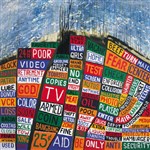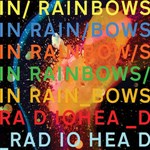
BY ALTUĞ KARAKURT (EE/III)
altug.karakurt@ug.bilkent.edu.tr
This week, I will be finishing my review of Radiohead’s discography with their late-career releases, in which I think the band perfected their sound, producing two masterpieces that are not only the crowning achievements of their career, but also among the highlights of the entire rock music genre. This week, I will talk about “Hail to the Thief” and “In Rainbows” and explain what makes them such outstanding albums.
Hail to the Thief
As I noted in my previous column, Radiohead had set the bar so high with “OK Computer” and “Kid A” that their follow-up, “Amnesiac,” felt more like a demo/B-side release than an actual full-length album. “Hail to the Thief” is the record where Radiohead came back with a completely satisfactory output for the first time since the release of those two groundbreaking albums.
This album provides a matured, characteristic sound after the various transition phases the band went through in their earlier years. In my opinion, “Hail to the Thief” is the first album that features Radiohead’s definitive signature sound. Despite the well-deserved success of their earlier releases, the band had continued to try out different directions in each of their follow-ups. After this record, they stayed in the same spot with their next release, “In Rainbows,” having, I think, found the sound they had been searching for.
The opener, “2+2=5,” is one of my favorites from the album, featuring very colorful and creative instrumentation. The next track, “Sit Down. Stand Up,” is an example of the band’s experimentation with electronic sounds and is quite an interesting number in their catalog. “Sail to the Moon” is an early highlight on the album; this is a piano-led, mellow track and one of the most beautiful compositions on “Hail to the Thief.” The following track, “Go to Sleep,” is one of the album’s most progressive tracks, in which the band’s sound builds step-by-step from a slow, ballad-like introduction. Then, the album’s greatest highlight—“Where I End and You Begin”—kicks in. It is a very catchy, creative and emotional song, and a clear hint of what to expect from “In Rainbows.” Another track that stands out is “There There,” which shines with its mellow and moody introduction and the grandiose, layered wall of sound that develops at the end. Toward the end of the album, “Myxomatosis” and “Scatterbrain” are memorable moments, the first being a very out-of-character electronic composition that is surprisingly well executed, and the latter a quite beautiful and elegant singer—songwriter-style track.
In Rainbows
This album includes the signature stylistic aspects of its predecessors but has a unique sonic character that makes it seem like the previous Radiohead albums were mere attempts to achieve the personality found here. It features the most colorful and catchiest tracks in the band’s catalog, as well as very moody and atmospheric compositions. Even after hundreds of listens, I am still amazed by the way they managed to fit so much artistic expression and emotion into such minimalist compositions and song structures.
The album starts off on an odd note with the synthetic beat of “15 Steps,” which then evolves into a typical Radiohead song with mellow guitar leads and groovy basslines. Thom Yorke’s vocals stand out in this track just as in the rest of the album, due to the relatively soft and calm tone he employs. The track then decomposes to electronic noise, resembling some parts of “OK Computer,” and leaves the stage to another fast-paced and rhythmic number, “Bodysnatchers.” The second half of this track, in particular, is very intense and features amazing musicianship, marking one of the greatest achievements of Radiohead’s career.
 After these two tracks, the album slows down and draws the listener into a much more emotional mood with Yorke’s hazy vocals, accompanied by smooth, layered synths, acoustic guitar arpeggios and thick basslines by Jonny and Colin Greenwood. This part of the album starts out with the mellowest track on the album, “Nude,” which has a very laid-back, chill mood and beautiful harmonic leads. The same style is carried on in the next few tracks: “Weird Fishes/Arpeggi,” “All I Need” and “Faust Arp.” The first of these deviates slightly from this approach and again resembles the “OK Computer” era of the band, with a very dark and depressive second half. The next track is a beautiful love song with twisted, peculiar lyrics. The last of the three, “Faust Arp,” is my least favorite song on the album, as it is too ordinary an acoustic track for such a unique record.
After these two tracks, the album slows down and draws the listener into a much more emotional mood with Yorke’s hazy vocals, accompanied by smooth, layered synths, acoustic guitar arpeggios and thick basslines by Jonny and Colin Greenwood. This part of the album starts out with the mellowest track on the album, “Nude,” which has a very laid-back, chill mood and beautiful harmonic leads. The same style is carried on in the next few tracks: “Weird Fishes/Arpeggi,” “All I Need” and “Faust Arp.” The first of these deviates slightly from this approach and again resembles the “OK Computer” era of the band, with a very dark and depressive second half. The next track is a beautiful love song with twisted, peculiar lyrics. The last of the three, “Faust Arp,” is my least favorite song on the album, as it is too ordinary an acoustic track for such a unique record.
The next and last part of the album is the absolute climax of Radiohead’s creativity. “Reckoner” is easily one of the greatest songs in the genre, projecting a very emotional and dark mood, and captivating the listener with its very minimalist instrumentation and an intoxicating vocal performance by Yorke. The same pattern is followed in “House of Cards,” which doesn’t really feel like a separate track, but instead like the second half of its predecessor. Next comes one of the most popular Radiohead songs, “Jigsaw Falling Into Place,” which perfectly combines the emotional style employed in this part of the album with the catchy, rhythmic character of the first part. This track also ties together the various sounds employed in the album, making it a very concise work of great harmony. The closer, “Videotape” is an ode to the band’s earlier, dark sound; it’s an elegant, beautiful piano ballad with a very emotional atmosphere. In this track, Yorke shines both as a pianist and as a singer. The album finishes on such a high note that I always feel like I’m left hanging, wanting more of this amazing musical journey. This is when I pull out my “Hail to the Thief” CD and try not to think about the fact that “In Rainbows” was the last decent record that these musical geniuses released together.
